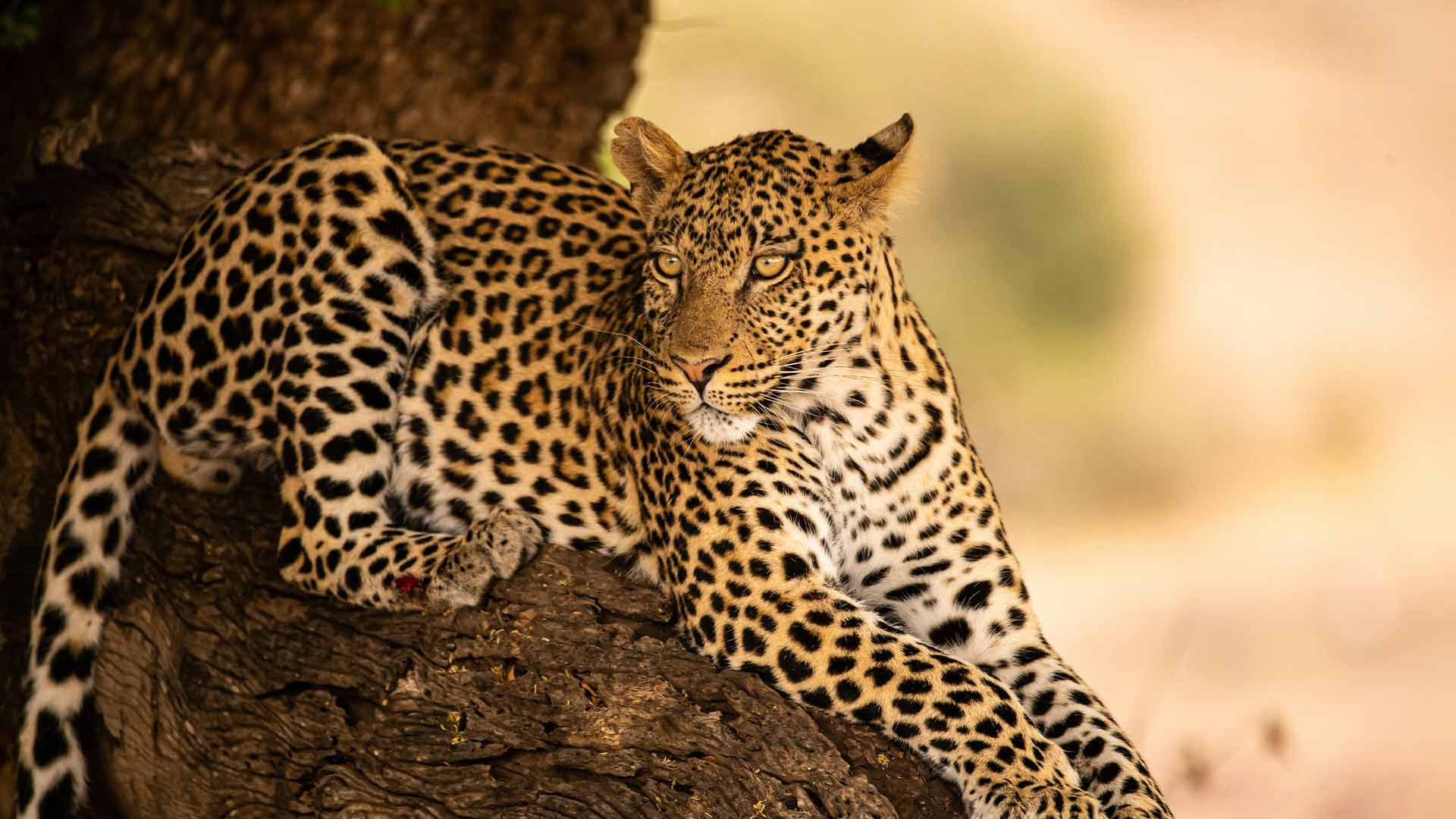African Leopard

Overview
Scientific Classification
- Kingdom: Animalia
- Phylum: Chordata
- Class: Mammalia
- Order: Carnivora
- Family: Felidae
- Genus: Panthera
- Species: Panthera pardus pardus
Description
The African Leopard is characterized by its golden-yellow coat covered in distinctive black rosettes, providing effective camouflage in varied landscapes. Adult leopards typically weigh between 60 to 90 kilograms, with males larger than females, and display muscular bodies, powerful jaws, and retractable claws essential for hunting and climbing.
Size and Weight
Coat and Coloration
The leopard’s coat is characterized by a golden-yellow to tawny background color, adorned with distinctive black rosettes and spots. This camouflaged pattern aids in concealing the leopard within its natural environment, whether in savannah grasslands, dense forests, or rocky terrain. Melanistic individuals, known as black leopards or panthers, exhibit a dark coat due to high melanin levels.
Body Structure
African Leopards have muscular bodies with a sleek and agile build, ideal for climbing trees and navigating diverse landscapes. They possess powerful jaws equipped with sharp, retractable claws that aid in hunting and climbing. Their long tails, which can measure up to 1 meter (3.3 feet), assist in balancing and maneuvering during pursuits and tree-climbing activities.
Senses
Leopards have keen senses, including sharp vision for detecting prey from a distance, acute hearing to detect subtle sounds of potential threats or prey movements, and a highly developed sense of smell for scent marking, tracking, and identifying potential food sources or competitors.
Adaptations
Behaviour
Leopards are solitary and nocturnal hunters, adept at stalking prey with stealth and precision. Their behavior includes ambush tactics, tree-climbing abilities to hoist kills for safekeeping, and a wide-ranging diet consisting of small to medium-sized mammals, birds, and occasionally larger prey like antelope.
Solitary Nature: African Leopards are primarily solitary animals, with adults occupying and defending territories that range in size depending on factors such as habitat quality, prey availability, and competition from other leopards or predators. These territories are marked through scent marking, vocalizations, and occasional physical confrontations with intruders.
Nocturnal Activity: Leopards are primarily nocturnal hunters, preferring to be active during the night when their prey species are also more active. Their keen night vision, enhanced by tapetum lucidum in their eyes, allows them to navigate and hunt effectively in low light conditions.
Stealthy Hunting: Leopards are renowned for their stealth and ambush hunting tactics. They utilize cover and vegetation to approach prey undetected, relying on their camouflage coat and patience to launch surprise attacks. Leopards often drag their kills into trees to prevent scavengers like hyenas or lions from stealing their hard-earned prey.
Diverse Diet: African Leopards are opportunistic carnivores with a varied diet that includes small to medium-sized mammals such as impalas, gazelles, warthogs, and even smaller predators like mongooses or baboons. They may also feed on birds, reptiles, and occasionally scavenged carrion.
Tree Climbing: Leopards are proficient climbers, using their retractable claws and powerful limbs to scale trees for resting, surveying their surroundings, storing kills, or escaping potential threats. Their arboreal abilities provide them with additional safety and strategic advantages in their hunting and territorial behaviors.
Territoriality and Communication: Male leopards have larger territories that overlap with several female territories, while females typically have smaller, more exclusive ranges. Leopards communicate through vocalizations, including growls, roars, and meows, as well as scent marking through urine and feces to delineate territorial boundaries and signal reproductive status.
Reproductive Behavior: Leopards mate throughout the year, with females exhibiting estrus cycles and attracting male suitors through vocalizations and scent cues. After a gestation period of about 90 to 105 days, females give birth to a litter of 1 to 3 cubs, which they raise alone in secluded dens until the cubs are old enough to accompany them on hunts.
Habitat
African Leopards inhabit a range of habitats, including savannah grasslands, dense forests, mountainous regions, and semi-arid landscapes. They are found across sub-Saharan Africa, with notable populations in countries such as South Africa, Kenya, Tanzania, Botswana, Uganda, Zambia, and Zimbabwe, showcasing their adaptability to diverse ecosystems.
Conservation
The conservation status of African Leopards varies across their range, with regional populations facing different threats. Overall, leopards are listed as “Near Threatened” by the International Union for Conservation of Nature (IUCN) due to habitat loss, poaching for their skins and body parts, human-wildlife conflict, and prey depletion. Conservation efforts focus on habitat protection, anti-poaching measures, community engagement, and research to ensure the long-term survival of these majestic predators.
Facts
Interesting facts about The African Leopard or Leopard (Panthera pardus pardus)
Adult African Leopards can weigh between 60 to 90 kilograms (132 to 198 pounds).
African Leopards are stealthy ambush predators, utilizing cover and stealth to approach prey before launching surprise attacks.
African Leopards have a diverse diet that includes small to medium-sized mammals, birds, and occasionally larger prey like antelope.
In the wild, African Leopards can live up to 12 to 15 years, depending on various factors such as habitat and prey availability.
African Leopards communicate through vocalizations such as growls, roars, and meows, as well as scent marking to delineate territories.
African Leopards can reach speeds of up to 58 kilometers per hour (36 miles per hour) in short bursts.
The gestation period of African Leopards is around 90 to 105 days, after which females give birth to 1 to 3 cubs.
Yes, African Leopards are adaptable and can thrive in diverse habitats including savannahs, forests, and mountains across Africa.
Yes, African Leopards are proficient climbers and often hoist their kills into trees to protect them from scavengers.
African Leopards have a golden-yellow coat adorned with distinctive black rosettes and spots, providing effective camouflage in various habitats.
Other Animals
Explore fauna in Africa.






